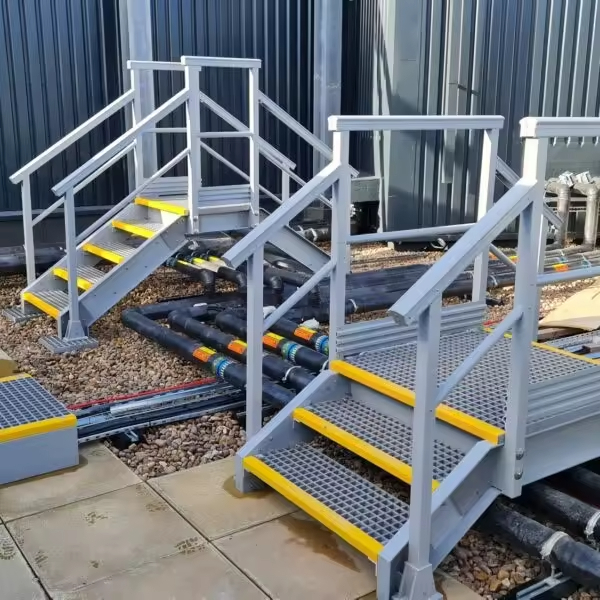- Home
- »
- Fibergrating's Blog
- »
- The Role of FRP Handrails in Accessibility and Inclusivity
Table of Contents
Importance of FRP Handrails in Inclusive Design
FRP handrails have become indispensable in designing accessible and inclusive environments. Fiberglass reinforced plastic (FRP) as a material offers numerous benefits, making it ideal for handrails in public, commercial, and residential settings. This article examines the role of FRP handrails in enhancing accessibility and inclusivity, along with their benefits for users and designers.
Durability and Low Maintenance of FRP Handrails
Firstly, FRP handrails are renowned for their durability and low upkeep. Unlike wood or metal, FRP resists corrosion, rot, and insect damage, ensuring longevity even in harsh conditions. This robustness is crucial in public areas where handrails face heavy use and potential damage. By opting for FRP handrails, designers ensure their installations remain safe and functional for extended periods.

Lightweight and Easy Installation
Another significant advantage of FRP handrails is their lightweight nature. Compared to steel or aluminum, FRP is much lighter, simplifying installation and transportation. This results in cost savings in labor and materials, and reduces environmental impact during construction. Additionally, the lightweight nature of FRP handrails allows for greater design flexibility, enabling easy shaping and customization to fit various architectural styles.
Enhancing Accessibility and Support
A critical aspect of accessibility and inclusivity is catering to users with disabilities or mobility challenges. FRP handrails provide a secure grip and support, ideal for individuals needing assistance on stairs, ramps, or elevated surfaces. Moreover, the smooth surface of FRP handrails is easy to clean and maintain, ensuring hygiene and safety for all users.
Aesthetic Versatility and Customization
Beyond practical benefits, FRP handrails offer aesthetic advantages. Available in various colors and finishes, they can be tailored to match any environment’s design and style. This customization allows designers to create cohesive and visually appealing spaces. Additionally, FRP handrails can be painted or decorated, offering further creative possibilities.
Conclusion: Promoting Accessibility and Inclusivity
In conclusion, FRP handrails are vital in promoting accessibility and inclusivity across different settings. Their durability, low maintenance, lightweight nature, and customizable design make them an excellent choice for designers aiming to create safe, functional spaces for diverse users. By integrating FRP handrails, architects and builders can meet all users’ needs, contributing to a more inclusive and accessible society.

Comments
Frequently Asked Question
FRP (Fiber Reinforced Polymer) handrails are handrails made from composite materials that combine a polymer matrix with reinforcing fibers, typically glass or carbon. These handrails enhance accessibility by providing strong, durable, and low-maintenance support structures that can withstand various environmental conditions. Their non-corrosive and non-conductive properties make them safe and reliable for use in public and private spaces, ensuring that individuals with mobility impairments can navigate environments safely and independently.
FRP handrails contribute to inclusivity by offering a versatile and customizable solution that can be tailored to meet the needs of diverse user groups, including people with disabilities, the elderly, and children. The handrails can be designed to comply with ADA (Americans with Disabilities Act) standards, ensuring that public spaces are accessible to all individuals. The ergonomic design and tactile surface options also provide additional support and comfort, making public spaces more welcoming and usable for everyone.
FRP handrails offer several benefits over traditional materials like wood, steel, or aluminum:
- Durability: FRP handrails are highly resistant to weathering, corrosion, and UV radiation, leading to a longer lifespan and reduced maintenance costs.
- Safety: The non-conductive nature of FRP materials makes them safer in environments where electrical hazards may be present.
- Lightweight: FRP handrails are lightweight yet strong, making them easier to install and reducing the overall load on supporting structures.
- Customization: FRP handrails can be manufactured in various shapes, colors, and textures, allowing for greater design flexibility and the ability to meet specific accessibility requirements.
Yes, FRP handrails must comply with several regulations and standards to ensure they meet accessibility and inclusivity requirements. In the United States, the Americans with Disabilities Act (ADA) sets forth guidelines for handrail dimensions, heights, and clearance to ensure they are accessible to individuals with disabilities. Additionally, building codes such as the International Building Code (IBC) and standards from the Occupational Safety and Health Administration (OSHA) provide specifications for handrail safety and performance. Compliance with these regulations ensures that FRP handrails are safe, accessible, and inclusive for all users.
